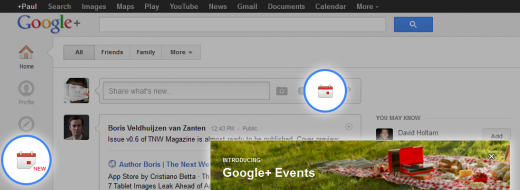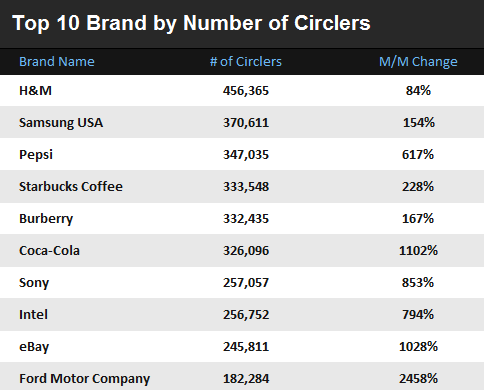
Has it really been a year already? Apparently so. Google launched its latest attempt at producing a successful social network on June 28, 2011. We were on hand at the time, as it happens, to bring you the complete video tour of the product at launch.
The debates, predictions and analysis kicked-off with immediate effect. What IS Google+? Who’s it aimed at? Is it after Facebook or LinkedIn’s throne? Should it be written as “Google+” or “Google Plus”? The social network was dissected and analyzed underneath a giant, global microscope. Verdicts varied wildly from “this is the best thing since bread arrived pre-sliced”, to “Google is wasting its time trying to pursue Facebook in the social sphere.”
These arguments raged – nay, rage – for one chief reason – there is no right or wrong answer. Most people broadly agreed post-launch that it was a nice design underpinned by a really neat ‘Circle-based’ social feature. But the hows, whys and whens of it are still largely being determined.
One thing we can probably say, however, is that Google+ is going nowhere. What started off last year as ‘another social network’ morphed into something a little more. The plan isn’t to provide another platform for users to share pictures of their cat doing funny things – it’s a social layer, not a social network. It’s more of a glue that brings together all Google products.
As we look back on a year in the life of Google+, we focus not so much on whether Google+ can topple Facebook, but more some of the milestone moments, observational tidbits and other random incidents that have taken place around the platform over the past twelve months.
In the beginning…
We all kind of knew that Google was working on a major social product, but we didn’t know what it would look like until it launched. While Google’s Android has often been mocked for its ugly interface (juxtaposed against iOS, at least), Google+ was widely acknowledged as looking, well, nice.
“The trademark minimalism is still present, but it’s been done with style and is something to be appreciated,” we wrote at the time. The reasons it seems is because interface designer Andy Hertzfeld, a member of the original Apple Macintosh team, was given free reign over design decisions.
Launching initially as an invite-only social service, the questions started arising as to Google+’s relevance problem, namely – where exactly did it sit in the current scheme of things? It soon became clear that it would serve as a business networking tool as well as a social networking tool, with Circles enabling people to create walled silos of contacts, depending on the nature of their relationship.
Moreover, it didn’t take long for the first creative campaign to launch around Google+, less than a week, as it happens.
pH Creative from Israel saw the increasing demand for Google+ invitations, and the company had heard about a workaround that would allow you to invite people by tagging them in a photo. So pH went to work creating an image that was nothing more than an invitation, then tagging anyone in the marketing industry who dropped them an email requesting to be invited.
As folk got more acclimatized to what exactly Google+ was, ideas started to flow as to what it could be used for, though we also took the liberty to suggest some key features that would improve the platform.
The inevitable issue of bugs also arose – on July 9 2011, the first notable technical issue arose, with some users reporting receiving multiple email notifications. Hardly the end of the world, and Google posted an apology for the bug, but Google+ had finally arrived (we jest).
Perhaps a sign that he wasn’t running scared from Google, Mark Zuckerberg even set up an account and was flying high on the followers list at first, though eventually tapered off.
Talk about bizarre. British-born Tokyo resident Joseph Tame ran a half-marathon along a route that he mapped out to resemble the Google+ logo:

Using a combination of RunKeeper to track the run on one iPhone and Google Earth on a second iPhone to see which way to go next, Tame ran over 21km around the streets of Tokyo. Tame said:
“Planning the route with Google Maps beforehand took about 90 minutes – it was tricky to get everything in proportion given the road layout. Unfortunately I accidentally picked up an iPhone 3G instead of a 3GS (for his second iPhone) – it was sooooo slow, and in fact in the end the GPS packed up altogether (possibly due to the fact that it was connected to a mobile router that has a habit of getting its coordinates in a twist).”
It’s also worth mentioning Orkut…Google’s ‘other’ social network, which was still hugely popular in Brazil mainly. We noted that while Orkut would still prevail in the short-term and faced no immediate threat from Google+, it may be only a matter of time before it would succumb to one of the more global-centric social platforms. As it transpired, Orkut did eventually relinquish pole position in Brazil, but not to Google+.
With no desktop client, it was surely on a matter of time before a third party arrived to the rescue, right? Right. Three weeks after Google+ launched, Gclient hit our radar, letting you receive notifications from your system tray, as well as access other key features.
With Google and Apple in direct competition in the mobile space, it wasn’t entirely clear when, or if, Google+ would arrive on iOS. But it only took a few weeks, hitting the App Store on July 19.
Going global
Any good social network caters for a global market, which is why the Internet giant rolled out Google Translate to Google+ via a Chrome extension, two months after launch. Though as we reported a week later, it was struggling to gain traction in Asia, a potentially huge market for Google+, and one that Facebook was still looking to gain ground in.
No official figures were ever given, but by September we were hearing that 43 million people were now using Google+, just as the Internet giant announced that you would now be able to share your favorite Circles with anyone you like, publicly.
Part of the allure of Google+ Circles was that they were hidden, so it was interesting to see what kind of reaction this would get. Obviously if you’ve created a master circle of funny people or tech bloggers, they’re perfect to share with a friend. If you’ve created a circle of ex-girlfriends, perhaps you won’t want to share that.
Google gaming
Google+ as a social gaming platform? Absolutely. Google+ continued to roll out updates to the gaming side of things, as the battle for supremacy in the online gaming space heated up. The likes of Global Warfare from Kabam and CityVille from Zynga were added to Google+, and as we predicted at the time, it could only grow as a social gaming platform.
However, despite all the bluster going on around the social network (sorry, ‘social layer’), Google indicated on more than one occasion that it was looking to the longer term, rather than playing up to the hype by focusing on quick-wins. The idea, it seems, was that if it gradually iterated the serviced, rolling out improvements and reeling in users incrementally through organic means, it would be a much strong proposition for the long haul.
As already mentioned, Google has sought to distance itself from the confines of a ‘social network’ – remember, it wanted to be the glue that keeps everything together. With that in mind, Google VP of Product Bradley Horowitz made the simple but astute assertion that Google+ was the same thing as Google.
It wasn’t a standalone product, more a collection of tools and services to help Google cement itself (if it hadn’t done so already) as the top dog and number one go-to for ‘all things Web’. So if Google+ and Google are one and the same, by my reckoning Google might well be synonymous with ‘the Internet’. Just a thought.
Any social product worth its salt has a celebrity contingent to help propagate the good word. None other than Sean Parker emerged as a signed-up member of Google+, which wasn’t a massive surprise in itself, given that he’s one of the world’s most well-known Web entrepreneurs. But when the Dalai Lama and Archbishop Desmond Tutu decided to lock horns on a Google+ Hangout, well, that was surprising.
Britney Spears became the first user to hit one million circles, and President Barack Obama jumped on board the Google+ bandwagon, further catapulting the fledgling social platform into mainstream headlines.
Building a better product

If the first few months of Google+’s life was about finding its feet, getting the word out there and building a steady user base, the subsequent months up until today have been used to tweak, iterate and launch new features to make it a more appealing platform for both existing and potential users.
These updates heralded in deeper Google Reader integration, the ability to call telephone numbers from within a Google+ Hangout, Gmail and Contacts integration, better YouTube integration, an official share button and, as of yesterday, a new Events feature.
However, perhaps one of the biggest moves for Google+ was finally being rolled out for Google Apps customers, which had been a HUGE omission, given that they’re paying-users.
It would be remiss of us to at least not cover the Facebook/Google+ comparison a little bit, after all, it’s one that was made continuously throughout the year. In a BBC documentary, Mark Zuckerberg said:
“Yeah Google’s a great company and I think we want to look at and learn from everything that they do. But at the same time, people have shared a lot on Facebook and have already told a lot of their life story on Facebook. And we think that we have by far better tools for doing that.”
In other words, he thinks Facebook has a huge head start, and users won’t want to up sticks to Google+ any time soon. But, as we’ve noted in the past, the two platforms aren’t necessarily in direct competition. (see below for more on that).
What now?
On the eve of Google+’s one year anniversary, the Internet giant chose to reveal its latest vital statistics. 250m accounts, with 150m monthly active users. Throw into the equation a new tablet-centric app (which we previously noted that it needed), and an iPad-specific incarnation on the way, it’s fair to say that it’s been a good year for Google+.
But looking at number of users doesn’t really tell the whole story, and in itself doesn’t reflect success per se. How do these users engage with Google+? How often do they use it? Do they use it from their mobile phone? These are perhaps more important in terms of measuring success.
It’s also worth mentioning brands, which will play a big part in Google’s efforts to monetize. Back in November it launched Pages and Direct Connect, aimed at luring brands on board. It even provided a guide for companies to best use the platform.
Since the launch of Pages, Google+ has been trying to lure mainstream brands on board. Up until then, the most popular brands on Google+, were owned by the company itself. But Pages did something to awaken the corporate behemoths to this new social platform.
Back in February, we took a look at how many times a brand had been Circled on Google+, and it seemed that more of the companies were consumer brands than had been prior to Pages. Here was the list of the top companies using Google+:

If we’re to equate ‘Circles’ with ‘Likes’ on Facebook, you’ll note that while Coca-Cola, for example, had more than 40m Facebook Likes at the time, it only had 326,000 Circlers. So there’s no question it has ground to make up, but it is still early days and its standing is growing all the time.
One problem here, though, is the resources companies have at their disposal. Particularly with smaller firms, if they’re already ploughing cash into Facebook, will they see the need for Google+ too? And to really lure the brands on board big time, Google will have to demonstrate a broader consumer appeal for its social platform. I don’t know about you, but apart from my techie friends, I don’t know anyone who uses Google+, but I barely know anybody who isn’t all over Facebook.
Then there’s the API issue. Last September, the first part of the Google+ API was released, which was good news for third-party developers looking to integrate with the service. But it has limitations – only publicly available data can be tapped, which means the likes of Circles are off limits.
If Google+ can improve its API offering for developers, allowing them to tap a richer stream of data, then this will help it gain even more traction across the Web.
Google doesn’t have to worry too much about the uptake of its ‘social layer’ because, well, its Google. It can afford to take its time to transform Google+ into whatever it needs to be for it to continue to grow.
Crucially, Google hasn’t tried to play Facebook at its own game. That would never work – it has had to bring something genuinely different to the table, and I certainly feel we’re hearing fewer Google+/Facebook comparisons. They’re not the same thing.
However this next year pans out, it will be interesting to see what news Google has for us on the eve of its second birthday. 500m users? You never know.
Feature Image Credit: Hammer51012 | Flickr
Get the TNW newsletter
Get the most important tech news in your inbox each week.




